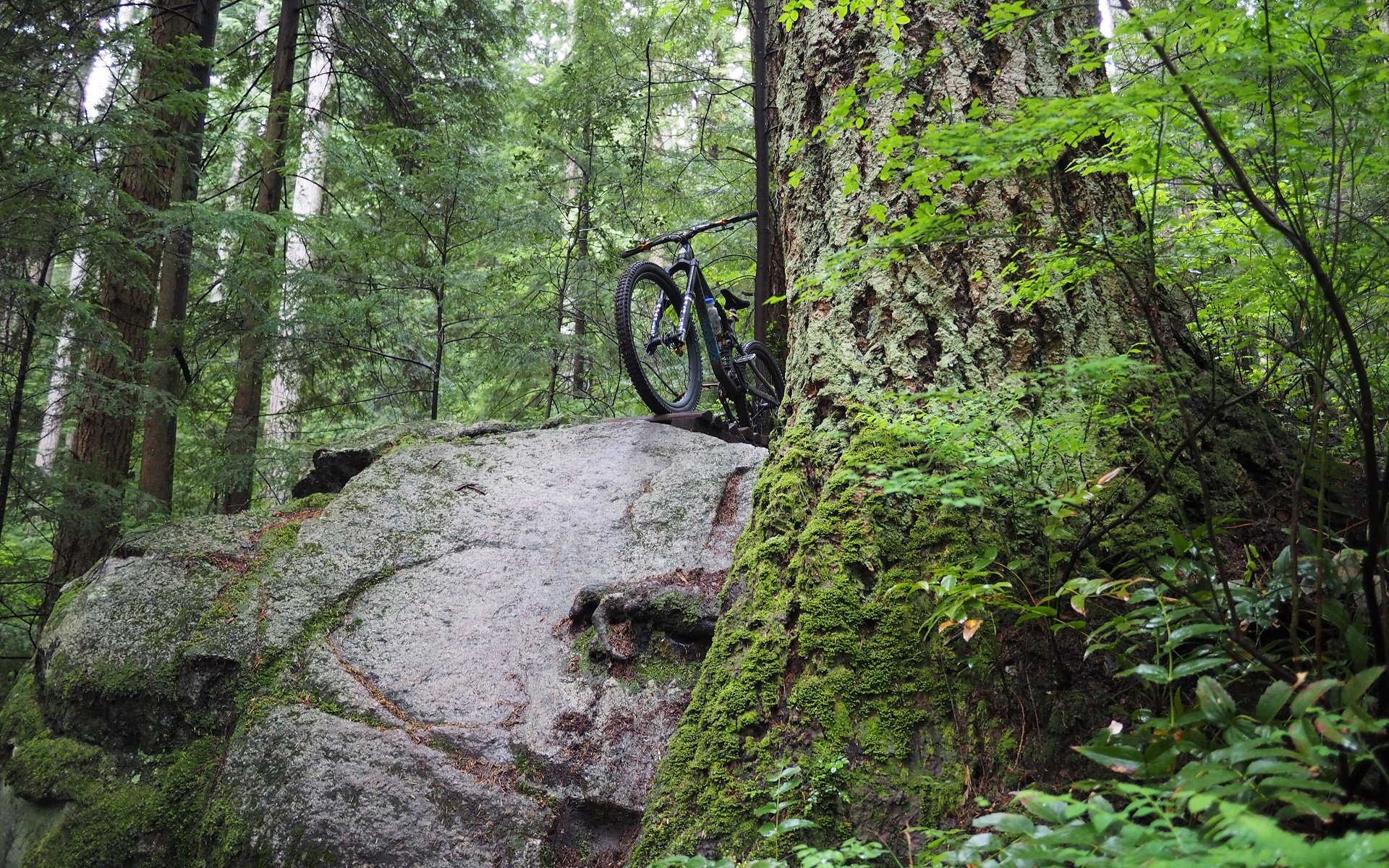
EDITORIAL
Over-Forking The North Shore
Standing Tall
The first bike I over-forked was a '00 Kona Roast. My local shop tracked down a frame from Kona's scratch & dent pile. I spent the better part of a day hand-filing an IS-to-PM adapter to fit the oddly sideways welded disc brake tab, which was well worth the cost savings, and then plugged a Marzocchi Jr.T onto the front. To this day I have a strange affection for hardtails with dual-crown forks.
Over-forking became part of my Tao when suddenly every second person I was regularly riding with owned a Knolly. Then I worked in a shop that sold Knolly bikes; a lot of Knolly bikes. And from there I started riding with even more folks who were full-on Knomers.* Just about every single one of these riders bumped up the front ends on their bikes. There were 150mm or 160mm Fox 36 forks on Endorphins, 170mm or 180mm Marzocchi 66's on Deliriums, and 200mm DH forks on V-Tachs.
*special Knolly fans
There's an argument to be made that Noel was too accurate about how much travel his frames were delivering, (or from his point of view how inaccurate some other companies were being) but I do note that in addition to plenty of riders I know, subsequent 'BC Editions' from other brands have bumped fork travel right from the factory.
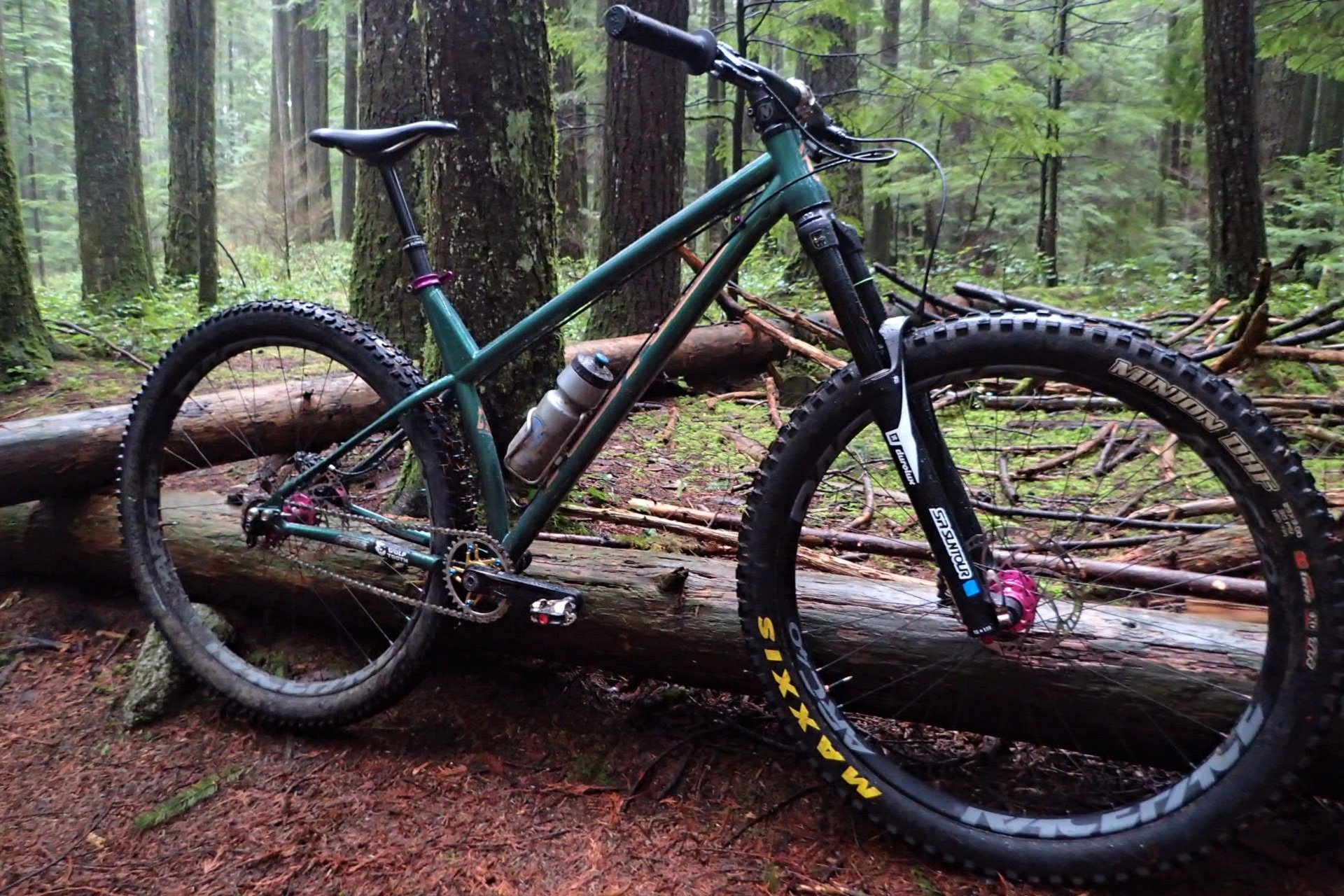
My Honzo ran a -2° Works Components angleset and my Durolux RC2-PCS set at 170mm travel. That's a 50mm jump from stock but only 30mm more than most folks I know run on their Honzo.
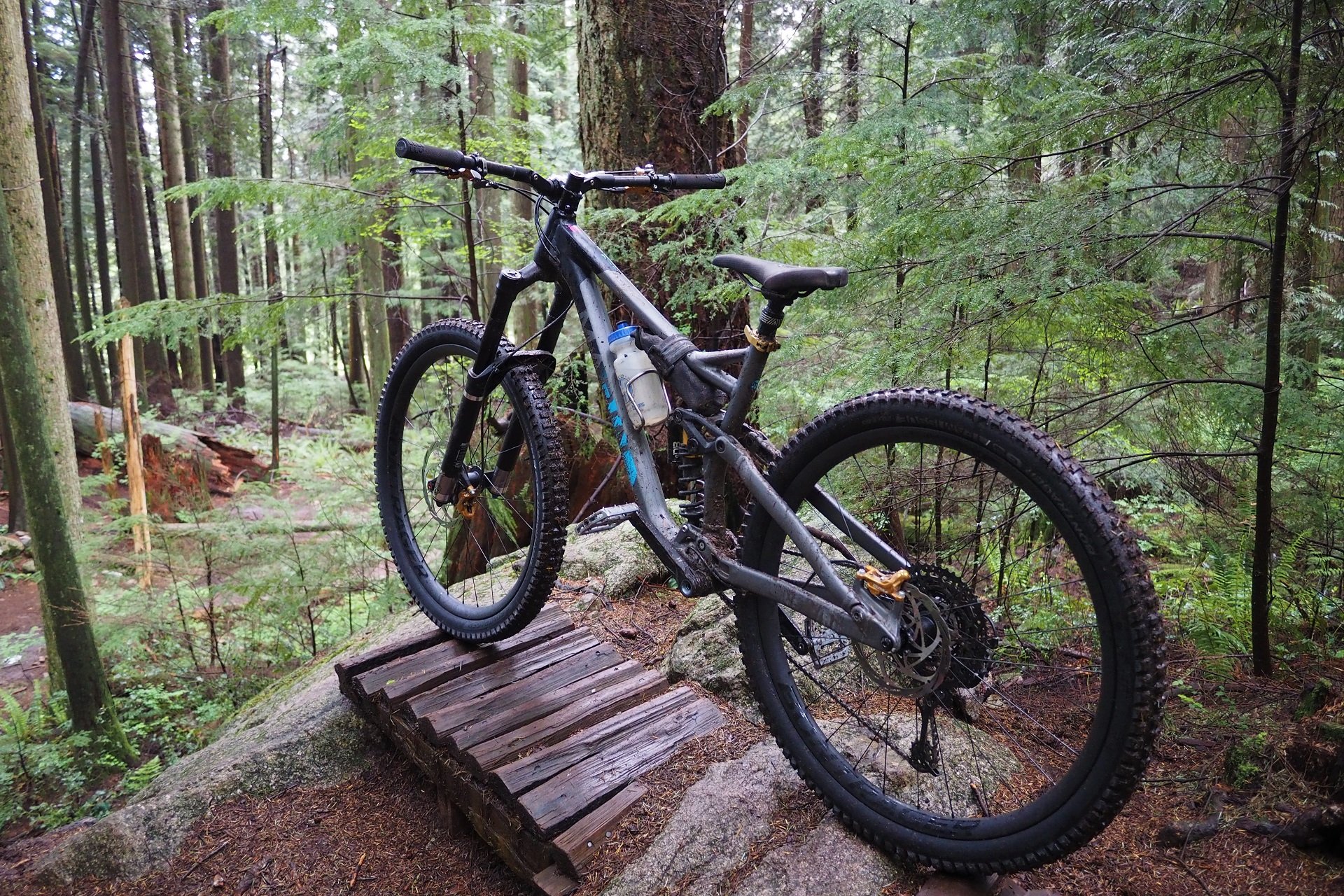
The Mezzer gracing the front of my Marin Alpine Trail is set to the full 180mm travel, which is 20mm over stock in addition to the IRT air system riding high in its travel.
Between 2011 and today I've met a remarkable number of Kona Honzo riders. A surprising number are running single speeds. and all of them have at least 20mm more travel than stock. I'm stupefied every year that the stock bikes ship with a 120mm fork. Particularly, a 120mm fork that can't cheaply and easily be bumped to 140mm.
On Mt. Fromme there are multiple generations bikes like the Specialized Enduro, Santa Cruz Nomad, and Kona Process - sporting 10mm, 20mm, 30mm, or more extra travel up-front. I'm starting to see more and more mullet bikes as well and 29" hoops on the front of a 27"-wheeled bike, jacking up the front end considerably.
Because seat angles are getting so steep on many bikes, significantly increasing axle-to-crown (a-to-c) height, via longer travel or a larger front wheel, doesn't ruin the bike's climbing position. For some of us, a taller front end actually creates a better seated pedaling position on top of any improvement to handling on steep terrain.
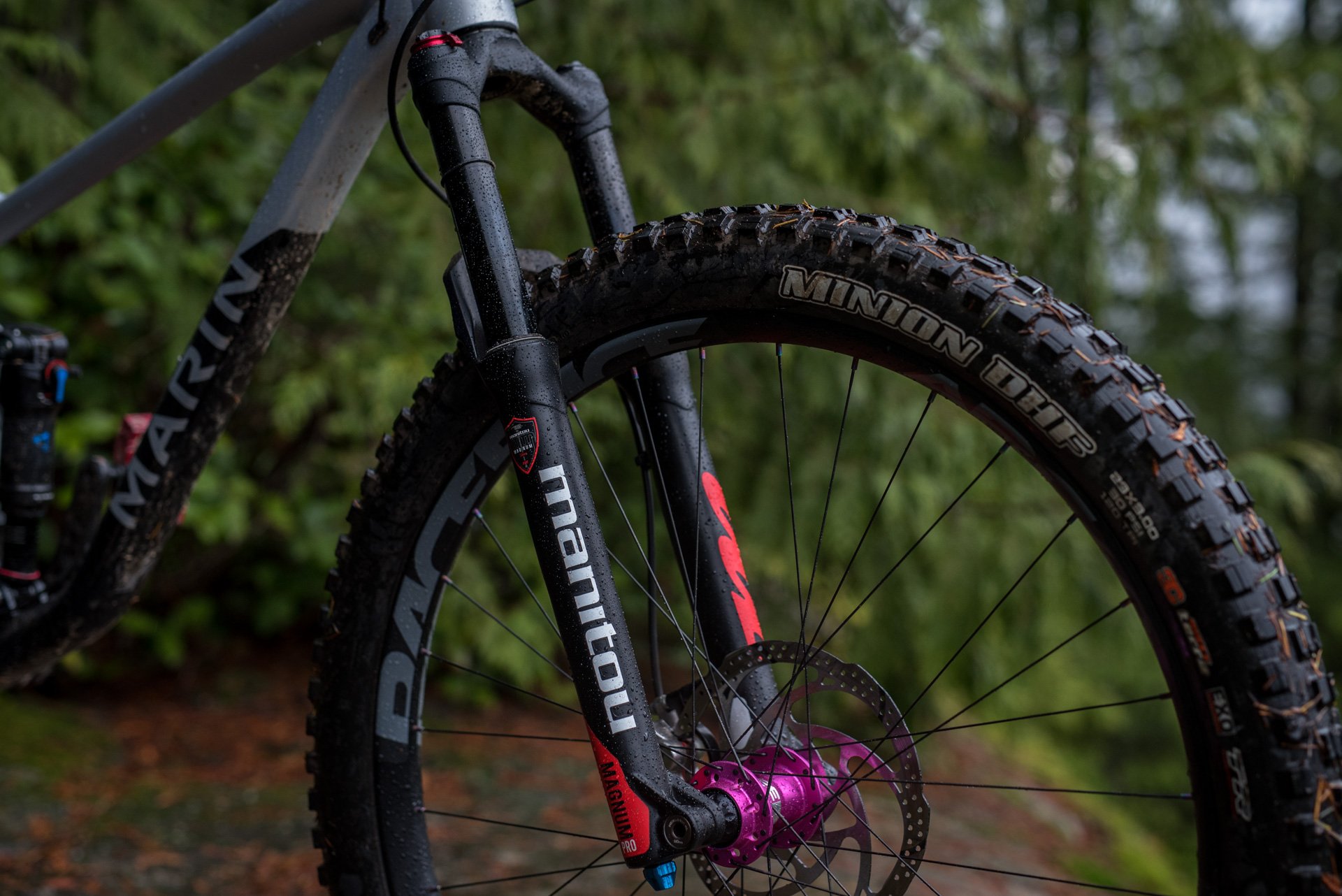
Ground-To-Crown height. This 120mm Mattoc and 29+ setup added about 30mm to the stock Rift Zone geometry. Photo: Dave Smith
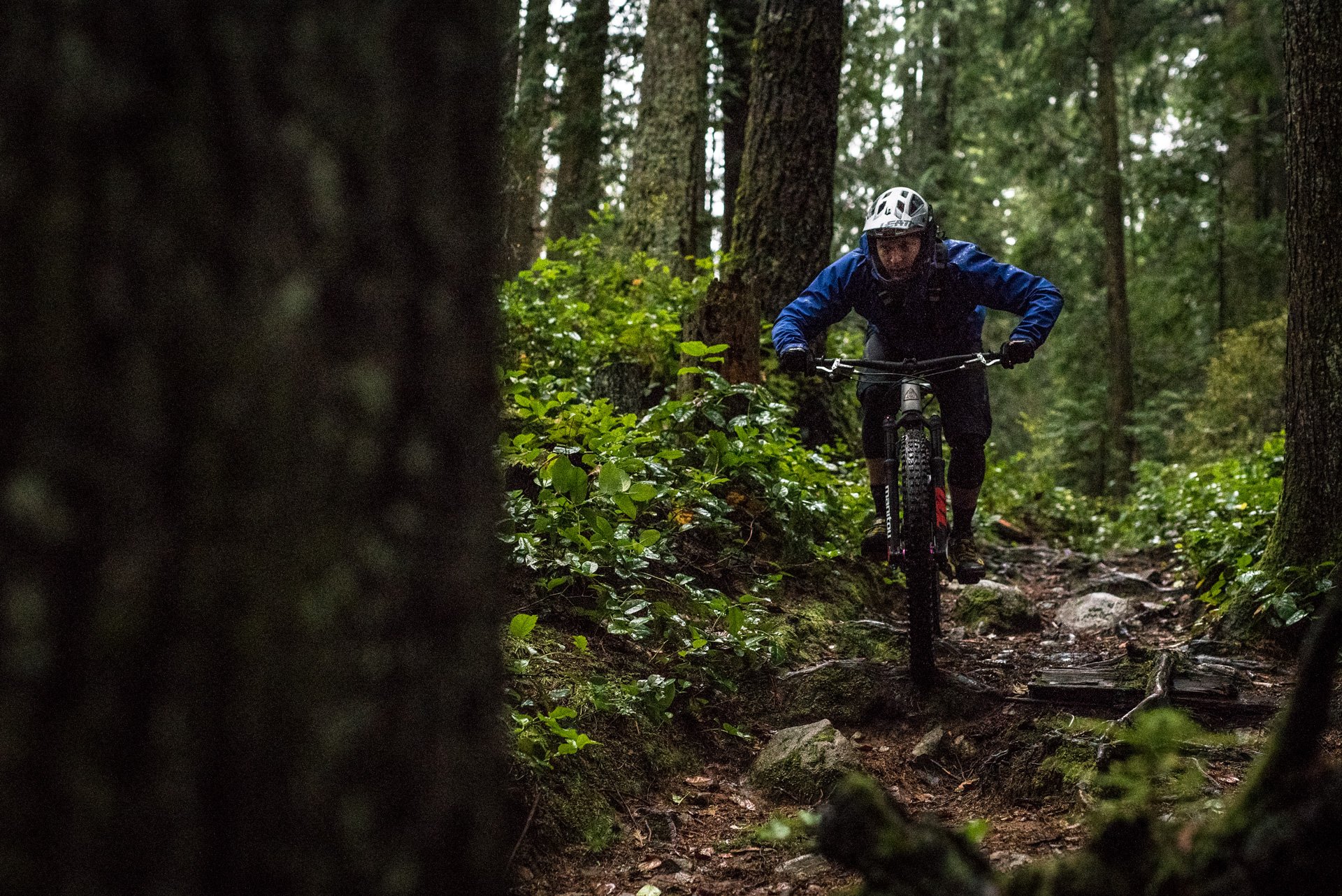
That's before taking into account the excellent composure, and relatively high ride-height, of the Mattoc's stand up IRT air system. Photo: Dave Smith
Seated position aside, over-forking a bike raises the Stack, shortens the Reach, and slacks out the head tube angle. But, it is absolutely key to note that these changes are all static. Bikes are usually set up with the fork firmer and faster - that is to say, less sag and faster rebound - than the rear suspension, on flat ground. Point the same bike down a steep trail and apply a whole lot of front brake and body English trying to negotiate the jank and the effective geometry ends up being pretty close to descending the same bike, with the stock fork travel, on faster downhill trails.
Unsurprisingly maybe, while these trends apply to North Vancouver, a funny thing happens when I use the magic of the internet to peruse trends in mountain bicycling elsewhere. There are Knolly's of every generation for sale with the 'proper' amount of fork travel, Honzos sporting 120mm forks and sometimes shorter, and a sea of bikes with 'balanced' travel numbers.
More and more bike companies are pushing platforms that have regular and limited production long-travel versions, (achieved through an increase in shock stroke) which run a 5-10mm longer travel fork v. rear travel right out of the box. Still, local riders are paying to bump forks to increase that gap to 10-30mm or replacing their forks altogether.
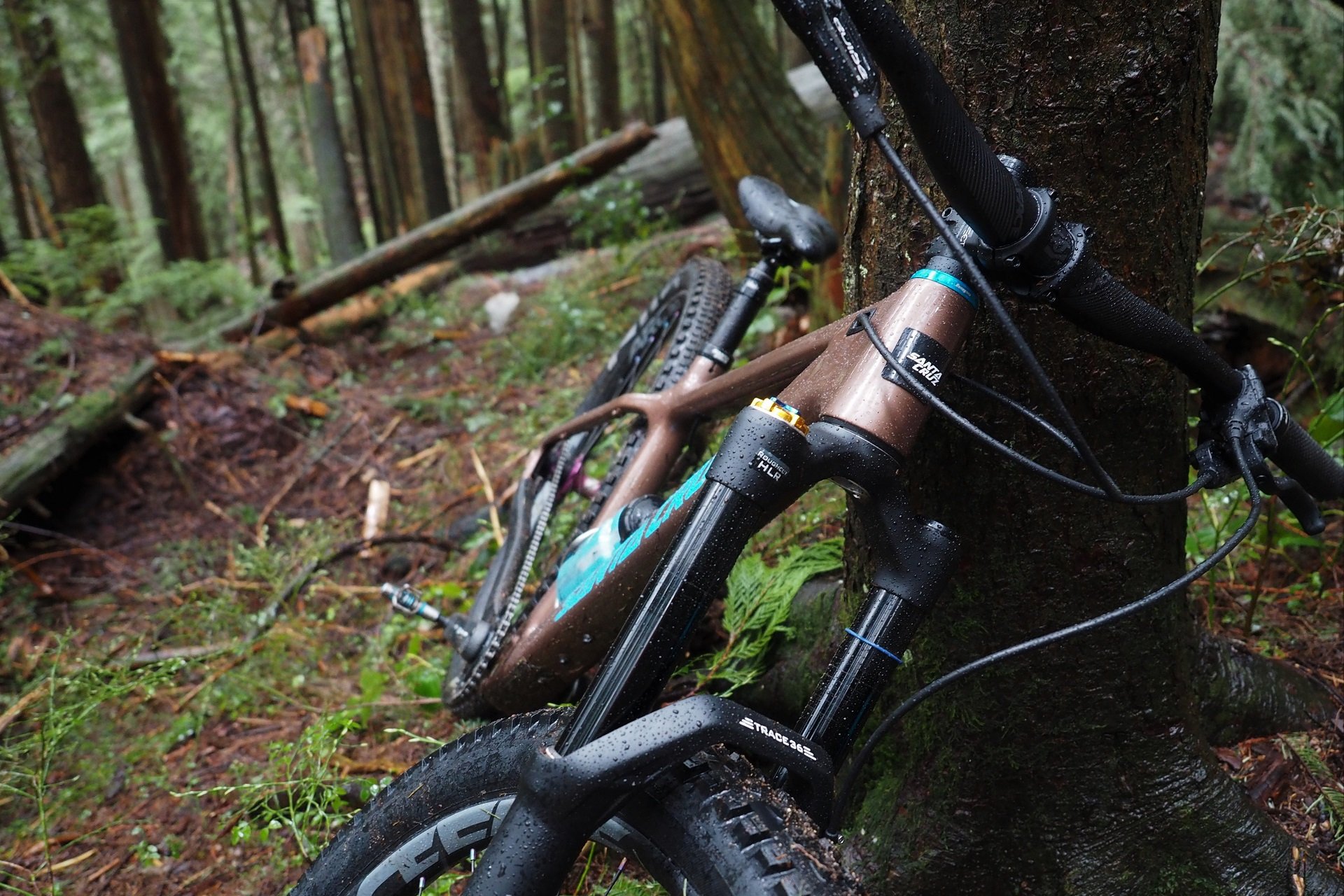
I rode the Carbon Chameleon with a Trace 36 set at 20mm travel over stock, and Boy George, was it an improvement for local terrain.
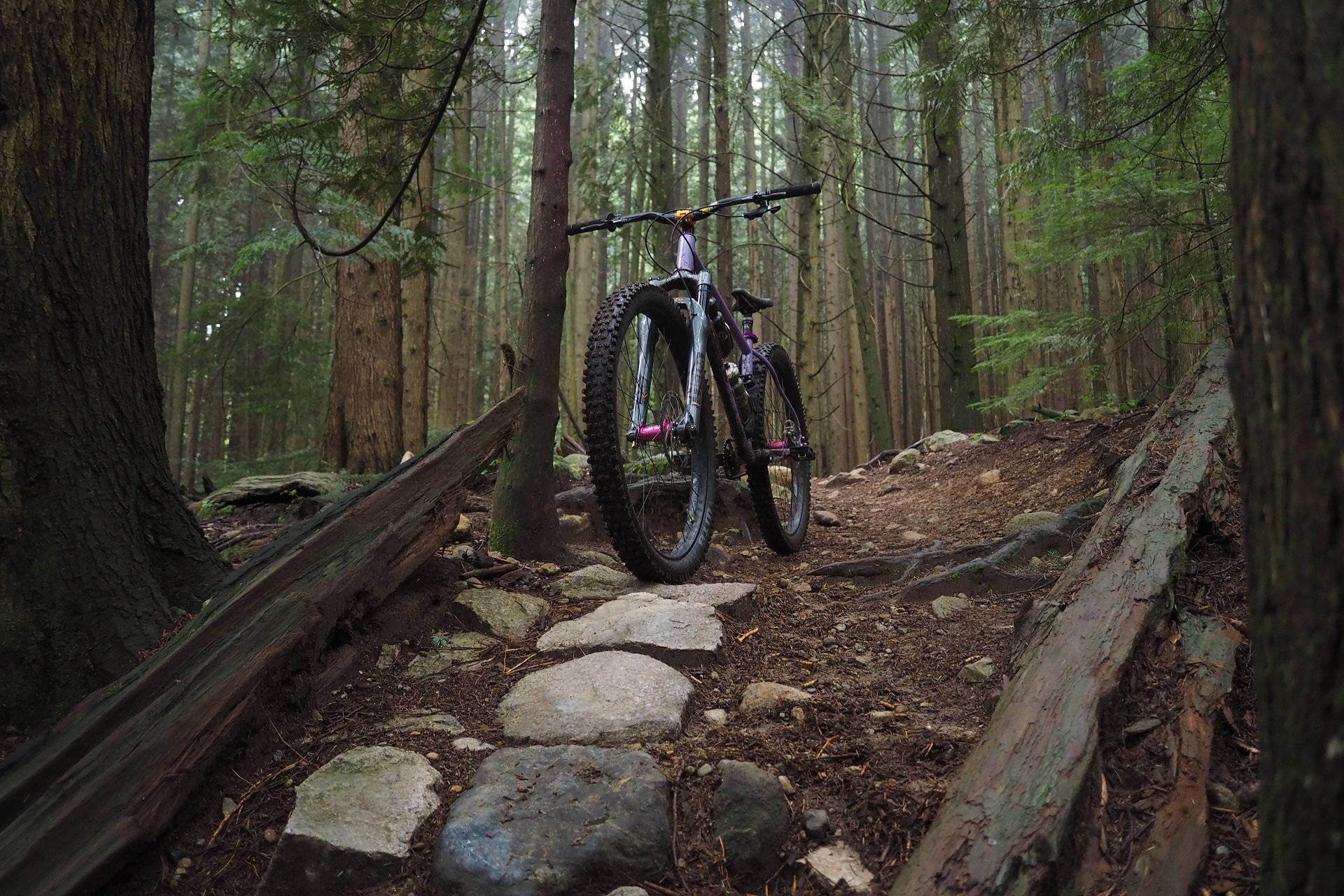
Even on my own custom Waltworks, in suspension mode, I'm running a 20mm longer travel fork than it was designed around.
If the suspension buzz for 2020 wasn't about forks that sit higher in their travel, I would think the desire for a taller axle-to-crown remains a BC-only issue.
Whether it's a shorter travel rig like the new Process 134, Santa Cruz Tallboy, or Specialized Stumpy, or something longer like the Rocky Mountain Slayer, Specialized Enduro, or Trek Slash the trend os similar. Folks are not asking if they should jack up fork travel, but rather how much is the right amount. I always say it's worth a shot if your fork is easily travel-adjusted because in my experience over-forking is as North Shore as big brakes and sticky tires.
Has anyone gone too far, or ruined the ride of their bike by over-forking or mulleting? A Monster T on a dirt jumper?

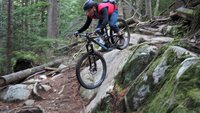
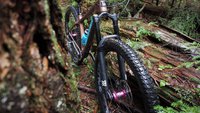
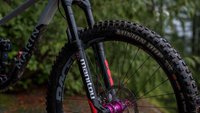







Comments
Velocipedestrian
3 years, 11 months ago
I've gone too far. DMR Trailstar designed for a 120mm fork running 170mm instead.
I didn't realise for a year or so, then did some experiments - found the sweet spot for handling on that frame is ~130mm. A harsher, but better balanced ride.
Less dramatic, but still too far - 170mm on a V2 Banshee Spitfire (designed for 150mm), the front was fine, good descending etc, but too much for the STA.
Good experiments though...
Reply
Andrew Major
3 years, 11 months ago
STA is absolutely a key factor on sit-to-climb bikes (all the hardtails pictured were run SS). I think it’s the saving grace of all the medium-large bikes coming with STAs suited for XXL.
Interesting on the hardtail. Certainly a balance between travel and HTA. I really enjoyed my 170mm Honzo (Durolux is a tall fork to boot) but with the Angleset it was sitting around 64* static so my 120mm Walt is actually slacker with sag.
I’d love to try a DH hardtail with a 170mm fork around 62 / 61
Reply
Mammal
3 years, 11 months ago
So Doctahawk then?
Reply
Andrew Major
3 years, 11 months ago
Not for me... I can’t wrap my head around the steep-steep static STA and the super short rear center.
I love the Arcturian but for the lack of sliding drops and even with an over-forking I’m not sure the STA could work for me. Maybe if we some point good offset droppers become available (to benefit riders needing steeper and slacker effective saddle positions).
Some sliding-drop hybrid Arcturian and Doctahawk?! Mmm. Back to where I’m on a custom hardtail.
Reply
Skyler
3 years, 11 months ago
STA and rear center are interdependent for making geometry work. Long rear centres can be a treatment for too-slack STAs, so that the weight balance isn't in permanent wheelie position. Similarly, you can enjoy the benefits of a short rear centre if the STA is steep enough to leave you in a balanced climbing position, and the reach is long enough to keep that balance forward on the down.
My point is, I think it missed a lot to pass judgement on a bike looking at numbers in isolation. Short chain stays have fallen out of fashion for some reason, but when paired with numbers that keep the weight balance healthy, what's the downside? All it really changes is how close your feet are to the rear axle, and how much you need to bend at the hips to stay centred on the bike.
Reply
Andrew Major
3 years, 11 months ago
In my opinion/experience it’s about weight balance between the wheels.
I’ve played around with wheelbase a lot on bikes with sliding stays (of various sizes) and both climbing and descending I prefer a longer rear center.
Changing the STA v. stays for climbing assumes you can still get a good pedaling position with a steep-steep STA; I can’t.
I’m already running long front centers and slack HTAs and have been upsizing and anglesetting for a while and feel very secure passing judgement off a geo chart, at least on hardtails, with really short stays for my use case. It’s not like I haven’t ridden a lot of them.
Off the shelf I think a large Growler is pretty much perfect as an all around hardtail (minus the lack of sliders). That’s 435mm stays / 75* STA. I’d so a bit slacker on the STA for my own use but it’s good.
-
In my experience the bike industry always goes too far in a direction (for the average rider) before swinging back. I think 410-415mm stays on trail bikes will prove to be an example of that. Other than manuals/wheelies there’s no downside/lots of upside of a more balanced weight distribution between the axles. Maybe not as far as I take it on my own bikes but in theory that’s the beauty of having lots of different companies making their best bikes - or custom.
Vik Banerjee
3 years, 11 months ago
I choppered out a old Y2K-era SC Heckler with the longest Marazochi fork I could get at the time [5" I think]. It was a bit silly and didn't ride all that great on the trails I had access to in Alberta at the time. But, it was interesting and I haven't stopped trying stupid mods with bikes since then. Some are even a good idea and make the bike ride better! ;-)
Reply
Andrew Major
3 years, 11 months ago
This was me pulling spacers out of the Mezzer on my Marin: “I can always put them back, maybe I’ll just change 1cm, no I can always put them back...”
It’s like bracketing any setting. Sometimes you have to go too far. I figured I’d be back to 160mm or settle at 170mm right away but 180mm/150mm really works. The Marin rides high out back so the IRT system does really balance that as well.
Reply
IslandLife
3 years, 11 months ago
Is it considered overforking if you add a Girvin Flextem to a fully rigid 1991 Rocky Mountain Fusion?
Reply
Andrew Major
3 years, 11 months ago
Definitely!
Pics or it didn't happen though...
Reply
IslandLife
3 years, 10 months ago
Ha, wish I had pics of that bike... actually wish I still had that bike! Those flex stems though, not so much... even 14 year old me went through 3 of them XC racing and riding the relatively tame trails of the Okanagan in one season.
Reply
Andrew Major
3 years, 10 months ago
I have a few bikes like that. My Balfa Minute Man and 2-Step and my Redline Monocog specifically. I’ve drafted stuff that includes each of them but it really feels like I need photos.
Reply
maxc
3 years, 11 months ago
As with most things in our balance sport of Bike, my experience is that the sweet spot is usually in a narrow range. Went from 160 to 170 fork once on a full suss and the 160 was amazing, 170 awful. I’ve a hard tail that’s ‘meh’ at 140 and ‘yeah’ at 160. It’s well worth experimenting and a great editorial :)
Reply
Andrew Major
3 years, 11 months ago
Thanks! The moral of the story is absolutely to experiment. It’s crazy the difference a cm can make anywhere on a bike from chainstay lengths to bar height.
Reply
Cooper Quinn
3 years, 11 months ago
Its hard to experiment with chainstay length on most bikes, tho.
Reply
Andrew Major
3 years, 11 months ago
Cooper, you know how I feel about aggressive hardtails without sliders!
I’m hoping all the FS companies R&D Santa Cruz’s adoption of slip-chip axle inserts for trail bikes. So many companies have done it with DH bikes, they can even claim they got the idea from themselves!
Reply
Andy Eunson
3 years, 11 months ago
Yes. I tried my Chameleon at the longest chainstay length. Climbs better and I sense no effect on other aspects of handling. 150 36 on it too. No idea what the seat tube angle is. Some interweb experts will tell you that the geometry will be destroyed and ruined. And the warranty will be void. We know better.
Being short I guess I don’t really get the steep seat angle thing. I need to be balanced on the saddle while pedalling. If my bb is to far back under me it causes me to lean forward and my hands go numb. Raising the bar alleviates this but sitting more upright is less efficient for laying down the power. The modern road fitting set up will get a rider on a trainer and while pedalling in a moderate gear you take both hands off the bar and slowly sit up. If you slide forward or pedal harder and faster or engage the core too much it’s because your balance is off. You move the saddle rearward to get weight balanced.
Reply
Andrew Major
3 years, 11 months ago
I guess one of the true beauties of single speeding is not having to think about how a bike climbs in 30/51t going up a wall in the saddle because it's hard to imagine where else a 77° STA on a medium or large frame makes sense. But yeah, on some bikes there's certainly a degree to which over-forking makes my seat climbing position better as well as my steep descending position.
Reply
Skooks
3 years, 11 months ago
Definitely. And it's very noticeable when you have gone past the sweet spot. Tried running a 160 mm fork on a spitfire and it felt wrong. Dropped it to 150 and it felt perfectly balanced. I just upped the travel on my Fugitive from 150 to 160, and I initially didn't love it. Removed a token, dropped some pressure, and lowered the stem a couple of mm and it's now perfect.
Reply
Tjaard Breeuwer
3 years, 11 months ago
You can look at it a few ways. One is: why not buy a bike that comes with a longer travel fork to begin with? Say instead of over-forking a Tallboy, get a Hightower?
On the other hand, I have done it plenty in the past, when bikes with a bit more travel up front and slack head angles were hard to find.
As a taller rider, the problem for me with over-forking is that is worsens many geo issues that are already bad for us:
For short riders the latter is possibly a benefit, but other issues are problematic:
Of course, all of these changes depend on the starting geometry. If you have a bike with low BB, steep HA and SA and long chainstays, it seems like a no brainer.
My thought is that geometry is king. A bit shorter or longer travel is less important than having the right geometry for you. So use what ever combination of wheel size, fork travel, head angle and eccentric shock bushings works to get the geometry where you want it, and don’t sweat about a bit longer or shorter travel.
This view might be biased by being 6’5”, where it is hard to find good geo bikes. The same I am sure holds true for super short riders. People in the middle of the bell curve are more used to being able to choose a perfectly fitting and handling bike, so they probably assign more importance to the amount of travel.
Reply
Hugo Williamson
3 years, 11 months ago
Absolutely!!
Reply
Andy Eunson
3 years, 11 months ago
Totally. If you can get what you want already built. My Chameleon when I bought it only came with low spec build kits. Crappy hubs that would likely be as smooth as Fred Flintstones wheels in no time, lame ass short travel fork, and brakes? SRAM level something. Might as well go back to v brakes than those. Low level SRAM drivetrain too. No dropper. So many things needed changing it made sense to pick and choose what I actually wanted.
Reply
Andrew Collins
3 years, 11 months ago
I'm going to find out soon. A gen 1 Pivot Switchblade (135mm) with a Fox 36 Talas set to 160mm in 27.5+ mode and 150mm in 29er mode
Many of my bikes run 10-20mm over forked no problem. The only bike I've been hesitant to go too far on is my Pole evolink 150, which is already very slack and long.
One thing I've noticed though is the need to correct the stack height on some of the bikes, e.g. I run a Syntace flatforce stem (-13mm stack) on my Focus Sam running a 180mm DVO Onyx sc.
Reply
Andrew Major
3 years, 11 months ago
Stack height is very much about the interaction with Reach. Pivots I’ve ridden, for example, I’ve always needed to slam the bar as the Stack has felt quite tall compared to Reach. Then I’ll be mounting 30mm rise bars and 30mm of headset spacers on a really long bike with the same Stack number. The takeaway is definitely to experiment!
I’m sure you’ve come across this but for anyone else thinking of using a TALAS-V to play with axle to crown height, do note that the air spring forms up a bit when the hydraulic TALAS system is engaged. I think it’s a great system (and similarly used it to drop just a cm or two) but worth noting.
Reply
Cooper Quinn
3 years, 11 months ago
Are you running the spacer?
If you *are*, removing the spacer and running a 160mm (or even 170mm) fork will likely reduce your overall stack when sagged.
Reply
Andrew Collins
3 years, 11 months ago
I was originally going to run another fork with the Switchblade but the Talas saves me having to muck around with the spacer. I might still run an angleset which uses an EC56 cup rather than a ZS56.
Reply
Allen Lloyd
3 years, 11 months ago
My favorite bike was a 90's SC Superlight that I overforked with a Zokie. It slacked it out and I ran a 50mm stem with rise and a nice riser bar. People would try it and hated how it climbed, BUT loved how it descended. I always joked that I built the bike to save money on front tires :)
Reply
Rob Gretchen
3 years, 11 months ago
Over-forking is near and dear to me... can't remember a bike in recent memory that I didn't experiment with over-forking? It definitely works for me in the Kootenays!!
Reply
IslandLife
3 years, 11 months ago
Over forked my 2019 Knolly Fugitive LT by 10mm to 160mm (135) out back... and it was awesome! Was running an MRP Ribbon Air so travel adjust was as simple as a lower leg service with spacers that are adjustable in 5mm increments. Considered trying 155mm, but never got around to it before selling.
Overforked my 2020 Warden as well by 10mm to 170mm (160mm out back). It’s almost finished it’s build, so no rides yet.
Reply
Karl Fitzpatrick
3 years, 11 months ago
Gen1 Ragley Blue Pig with 150mm fork.
Transition Double set to 100mm with a 150mm fork.
Avanti KISS single speed with 150mm fork.
NS Surge with 160mm fork (which is its specified upper limit).
Not sure most hardtails shouldn't be over forked if your priority is riding down all the things.
Reply
Andrew Major
3 years, 11 months ago
Double sounds beyond interesting. The eccentric model that was easy to SS? 26" Rear? What size tire could you clear?
Reply
Karl Fitzpatrick
3 years, 11 months ago
Never single speeded it but as I ride hardtails exclusively, I used it as my 'big bike' for shuttles and whatnot. Could fit a 2.4" aggro tyre no worries.
I maintain to this day that if it was the longer of the two sizes, I'd still have it.
Super strong, really fun and surprisingly able on technical climbs.
Seems it's one of of those bikes that everyone regrets selling...
Reply
Sandy James Oates
3 years, 11 months ago
I always overfork my bikes, it’s my physiological crutch to riding steep trails. 2003 Bullit with a Marzocchi 888rc.
Reply
Skeen
3 years, 11 months ago
Used to run a 888 set to 170 mm on my '05 stinky with 6" (so ~150mm?) In the rear. That was a sweet overfork for hucking until the frame failed at the bottom of the seat tube where it was welded to a plate above the bottom bracket.
Reply
John Delacruz
3 years, 10 months ago
I think overforking works better for the longer reach new school bikes. For the older bikes with a shorter reach, the bike may end up too short. In my case I had a small 2011 Haro shift overforked to 140 mm (20mm above stock). Since the frame was already short, the saddle could not be mounted forward to compensate for the slacker SA. Since the stock SA was already slack as is, climbing seated became harder.
I replaced the frame with another Haro Shift a 2009, but in size medium. This is the bike that I later overforked to 160mm (40mm above stock). With the medium frame roughly 25mm longer in reach, I had enough room to slam the saddle forward. I feared the saddle would break by being clamped to the very rear of the rail, so I then replaced the saddle with the shortest I could find. This would lessen the leverage if I sit at the nose of the saddle. With the saddle mounted forward, climbing seated was tolerable and tucking behind the saddle became easier.
So my formula for overforking are:
1. longer frame to account for shortening reach caused by longer fork
2. slam saddle forward to compensate for slacker SA (and longer frame)
3. shorter saddle to lessen the leverage caused by being slammed forward
Reply
Raymond Epstein
3 years, 11 months ago
The first bike I ever over-forked was a Klein Mantra in '99 with 130mm Z1 BAM. The Klein was soon gone and I put the Z1 on my Bianchi B.A.S.S. I was often the rider with the least gears and the most travel on group rides at that time. I have never felt like any of them went too far and I still do it today as my Honzo sits with a 160 Lyrik. My last couple of full suspension bikes I have kept at their given fork travel, but both were 160mm and the most recent got a -1 headset.
Reply
Andrew Major
3 years, 11 months ago
Do you run an Angleset in Honzo? I found that when I went past a 140mm fork I much preferred the overall ego with the -2* Angleset.
Reply
Raymond Epstein
3 years, 11 months ago
Short answer, No. Long answer, I did for a second when I still had the Revelation fork that the bike (2015 Honzo picked up on the cheap 2 years ago) came with. That fork was never meant for a rider like me (short, angry-bear-like cinder-block shaped creep) and I was out riding (flexed like cray) it rapidly. I ordered a -1 headset and rode it like that for all of a few rides before a Lyrik that had been cut too short (but worked for me just barely) fell into my lap. The bike now sits with a 66 degree head angle and I'd would prefer it down below 65 at least like my full suspension rig has ('17 Evil Wreckoning with a -1 headset). I adore the Honzo, but it's handling is far less forgiving of my less than stellar skill set. I may at some point pony up for a new set of Lyrik uppers to have room for a -2 headset, but I've kept everything on the low budget side of things and as such have trouble pulling the trigger on doing this. More than you wanted to know I'm sure. BTW, that Waltworks is badass even though riding something like that on the N Shore would probably kill me. Walt repaired a busted Surly frame of mine for a few bucks and some local beers. Maybe one day when I grow up I'll have him do something custom for me.
Reply
KavuRider
3 years, 11 months ago
I always over-forked my bikes. First one was an old Monster T on my 2000 Stinky after destroying the stock Z2 that it came with.
Currently running a Trust Shout (cheap score) on my Yeti SB5c. After some tinkering with handlebar height, it is starting to feel better, but since it rides so high all the time, I think it might be too much.
Reply
Andrew Major
3 years, 11 months ago
Monster T was such an aesthetically pleasing fork compared to all the sticks at the time. Looked badass on the front of everything - especially hardtails.
Reply
fartymarty
3 years, 11 months ago
And boy was it plush.
Reply
KavuRider
3 years, 11 months ago
Yeah the old school one with the machine crowns was so neat. Insanely plush as well.
Reply
demo7_rider
3 years, 11 months ago
I started with a 2008 Commencal Meta 5.5 over-forked with a 160mm 36 Talas. Since then there's been a 2008 Demo 7 with a 888, a 2011 Mondraker Dune with a 170mm XFusion Vengeance, a 2016 Whyte G-160 with a 170mm Lyrik and now a 2017 Firebird with a Smashpotted 180mm 36. Every single one was an improvement over stock.
Reply
materials-guy
3 years, 11 months ago
I still have my 2000 Kona Score which was made for a 100mm fork that I put a 170mm Manitou Sherman Slider on that is still on. This is with a 24" rear wheel (back to 26") to slacken it as much as possible.
I had Toby from Toby Cycle works add a gusset on the front end to handle the extra 70mm + dbl crown over stock
Climbed like crap but could ride down almost anything.
My main bike is a Yeti SB5 (127mm) with a 160mm 36 on it with a -1 deg Works head set
.
Reply
Andrew Major
3 years, 11 months ago
Kona Score is a cool/rare bike! Pics?
Reply
materials-guy
3 years, 11 months ago
Reply
Greg Bly
3 years, 11 months ago
Bought a Marz Z one perhaps a year after they hit the market. I mounted the four inch traveled fork to my steel hard tail Norco Rampage . At the time a four inch travel fork was considering only for full suss DH bikes.
The bike felt great on gnarly steep trails like Vic's, Nescafe and sawblade .
Oddly I recently built up a short travel under forked full suss bike with a 68 degree HT angle . Feels great on climbs . Lower BB is an issue.
Reply
Merwinn
3 years, 11 months ago
Put a 2003 150 mm Marz AM3 on a '01 Cove Stiffee (designed around 120mm) and the handling went to shit. I remember after the fact that the BB was sky high, but I had no idea that it would negatively affect the handling. Shoulda kept the original 120mm Bomber on it. More is not always better.
Reply
Andrew Major
3 years, 11 months ago
My Cove history isn’t great but I feel like the Stiffee hadn’t been split into Stiffee XC and Stiffee FR in 2001?
I am thinking you were already overforked at 120mm compared to what the bike was designed around?
Either way, yeah BB height and STA are major factors.
Reply
WalrusRider
3 years, 11 months ago
I'm running an MRP Ribbon Air on my Honzo at 160mm travel and it's sick. I haven't considered an angleset but now you've sparked my interest. I think I'll order a -2 degree and see how I like it. My FS bike is running about 63.5 degree head angle and I've really gotten used to riding a slacked out bike these days.
Reply
Andrew Major
3 years, 11 months ago
Hard to imagine you won’t love it. Gets the BB down a bit and the STA a little closer to stock while adding capabilities with a reasonable HTA when you’re 1/2 way through the travel controlling a steep rollout.
Reply
mike
3 years, 11 months ago
There was a time when they said 100mm fork. Was too much travel for the frame design. That never stopped us from slamming the Judy DH cartridge into a Judy XC. Hell my 1st full suspension bike was 5.5" in the rear. Only fork with enough travel back then was the Hannebrink . Or the Mr Dirt. So I had a 100mm Judy , and a 4.5" Mozo for a while till I got a Hank LT6.
Reply
Andrew Major
3 years, 11 months ago
The important questions are:
1) How many rides did you get on your Hannebrink between services.
2) How fast could you pull off a full service?
Reply
GhettoFunkRadio
3 years, 11 months ago
In 2014 I bought a '10 Gary Fisher Big Sur frame that had never been built up and overforked that bastard by 30mm with an '07 Fox Vanilla. I had no concept of geometry and what longer travel would do besides more squish; it was the only fork I could find at the time with a straight steertube. The thing was an absolute rocketship on the climbs but it was twitchy as hell on the descents (in hindsight it was an aluminum XC race bike with too much travel), but it was always a blast to ride.
Sold it a few years ago a guy on the 'shore. Actually saw it on fromme not too long ago!
Reply
Andrew Major
3 years, 11 months ago
My first 29’er was a Titus Ti. Too steep for riding around here (never mind riding Fromme in the winter on paper thin 2.1” Racing Ralph’s) so sold it in short order to a friend who wanted to XC race it.
A couple years ago I see it on Burnaby Mountain. Same custom Fox 32 RLC that James at SuspensionWerx built me, same Mango Sotto Voce King 1-1/8” headset - unmistakably mine anywhere in the world.
*Big Smile*
“Hey! That’s my bike!!!”
For a second I thought buddy was going to put up fists and call me into ring... but I managed to clarify that it ‘was’ my bike.
I love bumping into bikes I’ve owned and seeing them getting dirt.
Reply
cxfahrer
3 years, 11 months ago
1996 I put a Manitou EFC with 100mm into my 93 Serotta t-max. I quickly reduced it to 60mm. No suspension adjusted geometry!
Today my Capra feels just right with 170/170. Could be a bit slacker for the steep stuff, but not shorter. So no overforking.
Reply
Hollytron
3 years, 11 months ago
I have a process 134 that I am running a marzfoxy z-1at 140. The bike rides so good that my original overfork plan has gone out the window. I have not had the chance to take it out on the local steep an gnarly yet so that could change but the cornering is so good stock I cant do it. Anyone overforked a 134 yet?
Also any special treatment for the rear suspension when overforking ie: more air/tokens?
Reply
Andrew Major
3 years, 11 months ago
Original Process 134? Plenty of them over-forked although the STA can get too slack for most folks' liking really quick so best to combine over-forking with a Works Angleset.
You may have to increase air pressure to account for a rearward shift in weight bias. The only solid rule is the fork needs to be firmer & faster.
Reply
Hollytron
3 years, 11 months ago
Its the 2020 29er. Do you mean the fork needs to be set firmer and faster when overforking or just in general when compared to the shock?
Ive also toyed with the idea of doing the coil conversion on the fork which would mean going to 150.
Reply
Andrew Major
3 years, 11 months ago
The only ~ universal rule of suspension setup is your fork should be firmer and faster than the shock. I’m sure there are some out-there exceptions for linkage forks or multistage springs or whatever but if you’re bracketing settings at home that’s the basis to build your settings off of.
Put another way, if your settings are way out you’d rather be fighting to get over a front end that’s too firm than to have your rear end trying to buck you off like a cowboy.
I don’t know anyone who’s pulled the trigger on a 134 personally, but I wouldn’t be surprised if you don’t see them built with 150mm or even 160mm forks based on the current 153 and also the past Process generations where +10/+20mm is fairly common.
Reply
Hollytron
3 years, 11 months ago
Cool! Thanks for the chat I am going to speed up my fork and maybe just get the coil thingy and go for 150. Also lots of cowboys here in Oregon. I once was heckled while riding to a trail from a passing pick up truck: " Git a horse!"
Reply
DarioD
3 years, 11 months ago
I've run my Evil Following MB in two different configurations, both over-forked.
In its 29" form, I have a -1 Works Headset and a 140 Pike, which makes for a pretty fantastic all-around ride.
For the 27.5" alternate, I used a 160mm 36 up front, and got along with it pretty well, thought the dive of the fork made some deep tech a little cumbersome.
All in all, I'm fully sold on the long-fork life.
Reply
Brad_xyz
3 years, 11 months ago
Yep, I've overforked and mulleted both my last 2 bikes and love it for the PNW down hill riding. Since I live for the downs, I can live with the slack as ... seat angle but certainly don't love it. Short legs help. My current bike is a 2017 Transition Patrol with with a 170 mm 29er fork and wheel (stock was 160mm 27.5 fork and wheel). I sized up to a Large to somewhat compensate for the change in reach on flat ground.
Riding anything that is not overforked / mulleted now seems super sketchy to me - I feel like I constantly need to fight not getting tossed over the bars.
Reply
BadNudes
3 years, 11 months ago
I've over-forked a fork. a Fox 34 @160 feels pretty noodly, but acceptably 'compliant' @150.
Also running longer than recommended forks on all my bikes for years with great success. Personal favourite is my 2002 Turner XCE with Marzocchi Z1 Drop-offs @130mm and a fox vanilla rear shock. I hate to admit the lazy seat angle has me walking up some of the steeper climbs, but the thing is magical when up to speed.
Reply
Andrew Major
3 years, 11 months ago
Ha, the old Fox 32 150mm forks with QR lowers? Given, the Fox 34 at 160 can feel a bit noodly with a really stiff frame/wheel/cockpit but at least it's still rideable!
Love those older Horst Link Turners. Still a bit surprised that they haven't gone back to that design.
Reply
Millsr4
3 years, 11 months ago
I think I've over forked every mtb bike I've owned. I just bought a new Norco Fluid FS 1 and had the fork bumped up 10mm before I even rode it. A stout 120/140mm bike has been so much fun for our trails down here in Bellingham!
Reply
TucsonMike
3 years, 11 months ago
Back in 2008 in college I bought a specialized p.3 with a junior T off of craigslist. Mainly used it around campus in New Hampshire and an Urban Assault Bike and it was soooo much fun and so capable. As good as bikes have gotten that is the one that I still think fondly of. It felt like a chopper when I was riding around but could do massive drops to flat like nothing. Living in the desert now and our trails are super techy rocky and pretty slow so overforking isn’t too common out here (currently on a 2019 Bronson and 5010 and both bikes slay at stock set ups)
Reply
oldschoolsteel
3 years, 11 months ago
...I think I eventually over-forked all of my favorite bikes...
We used to over-fork our xc bikes with bombers, I still have a 98 Klein Attitude with way too much Marzocchi coil on the front. I see there's a few more people in the forums that also went that route. I remember when the bombers showed up the xc scene. Heavy, but still faster than a Judy SL. That's probably when the over-forking started for me. Actually, I think there's a slayer and a hammer in the attic that have a little too much travel on them too.
This article was timely for me. I just finished bolting 180mm of Z1 coil onto a 145mm trail bike. I almost went with the Mezzer (I re-read Andrew's articles about a dozen times) but the shops in Williams Lake didn't know much about them, and the service interval was just soooo long in the Z1. The fender from my Fox also moved over nicely and fit a 2.8 inch tire (That fender thing was not insignificant). I may also have fallen for the late 90s Italian coil nostalgia... which may be the only real reason Marzocchi still exists.
I was going to adjust the travel on the Z1 down to 160... but after fighting with the brake adaptors for a half-hour I decided I was done fidgeting with the fork. Also it looks cool. And seriously, why not try it... I might like it...
So, thanks to Andrew and all the posters for making me feel a little less ridiculous in giving a trail bike a 40mm travel boost. Even if it's only temporary.
...Let's just hope the head tube/downtube junction is also ok with it...
Reply
oldschoolsteel
3 years, 11 months ago
...With the spacers under the stem removed and a little more sag than the last fork, my ride height didn't change significantly with the 180mm fork... The geometry changed a bit, but it didn't kill the climbing... I might leave it at 180 for a few more rides...
Reply
Andrew Major
3 years, 10 months ago
This is exactly what happened to me when I 180’d my Marin. Except in addition to my 10mm headset spacer I also took 5mm out of bar rise. Still running 180mm!
Reply
bumVSmtn
3 years, 11 months ago
First over-forking was a Judy XC on my GT Timberline FS in 1998 followed by a Judy XLC on a Zaskar. Zaskar frame became an under-forked Bullit with the Judy XLC which got closer to forked with an upgrade to a Psylo XC. Over-forked an Orange MsIsle with a Boxxer for a hot minute in 2003. Quickly realized how ridiculous it was and swapped out for a Z150. Realized the issue was running the wrong frame for my intended purposes and swapped to a Banshee Morphine. The Morphine with the Z150 could have been considered under-forked as many people were running dual crowns at the time. That bike, setup SS with 2.6” tires, remains one of my favorite bikes I’ve owned. Fast-forward to today and I tend to over-fork bikes 10-20mm. Haven’t experimented with the dark arts of anglesets yet.
Reply
Andrew Major
3 years, 11 months ago
Z150 with the steel stanchions? That was a fork. That Banshee sounds wicked.
Reply
bumVSmtn
3 years, 11 months ago
First gen Z150 with the black stanchions and the silver darting- think they were steel. Such a fun bike- was my zero maintenance shuttle bike when living in Ashland. So simple and the geo was proper. The tires were Arrow racing- RIP!
Reply
Andrew Major
3 years, 11 months ago
Yep, that's the fork for sure. It was a beastly single crown but worked great and was as stiff as any single crown at the time.
Didn't love their tires, but I used to run their USA made rims (made at Sun Rim Factory) with great results. RIP indeed.
Reply
mike
3 years, 11 months ago
It just came to me. This is a deficiency of this site. Topic's like this should be in the forum. But they are on the main page. The forum sits idle for days at times. Even great topics just sit idle. A topic like this and we have over 50 replies. Not many forum threads with that many hits.
Just a observation. Forum concept is much easier to read than the BB format.
Reply
twk
3 years, 11 months ago
Yeah, but they intermix all the threads of discussion if applied to comments...
Reply
John Delacruz
3 years, 11 months ago
I started over forking a 120mm travel Haro Shift with a 140 travel RST Rogue. Then I moved to Switzerland where a friend invited me to ride Verbier bike park. He had gotten a new Canyon Torque (180/170mm) to ride the park, finding his Stump Jumper (150/150mm) undergunned. In the bike park, the trails were steeper than the backyard trails around Lausanne and had to be ridden much faster. The Haro and RST did not feel right. The fork would become harsh at high speeds, and the riding position felt perched forward.
When I opened the RST fork, I found that I had 20cm more travel available, so I adjusted it to the 160mm setting. I removed a washer that enabled lockout on the compression damper to make the fork plusher. I also added a -2 Superstar components headset. Taking the bike back to Verbier with this setup, it felt much better but right at the edge of its capability. It was afterall still a cross country bike, just overforked by 40mm.
Looking at the 2nd hand bikes for sale, I saw a 2009 medium size Morewood Mbuzi that came stock with a Lyrik and Fox DHX Air 4 (160/160mm). The bike was priced at 650 Francs. I hopped on a train to Zurich and got it as soon as I could.
I rode the Morewood in Verbier and felt the suspension was more appropriately plush for the park. But the riding position felt like I would fall right over the bars on steep trails. I replaced the headset with a Works Components -2 degrees angle set to slack out the HA from 68 to 66 degrees. I also added as many spacers as I could under the stem, then changed the handlebar to 50mm rise. The bike finally had a comfortable geo on the steeps.
We started exploring other Swiss bike parks. As our riding progressed my riding partner then upgraded from his Torque to a Sender.
Not having the budget for my own DH bike, I found a deal on a Marzzochi 66 (180mm) that the owner took off his Commencal and replaced with a Boxxer. I got the 66 for 50 Francs.
With the longer axel to crown height on the 66, I had to remove all the spacers under the stem on the Morewood. Standing the bike next to my old Haro Shift, I was surprised to find their handle bars ended up at the same height. At 180/160mm the bike felt great and finally gave me confidence riding down steep park trails.
Reply
Reaper
3 years, 11 months ago
Was running a 160mm 26" Lyrik on my older DMR Trailstar 2. Not particularly extreme overforking but it was only any good going down. Climbing and flat trails sucked. Dropped it to 140mm which is pretty much the sweet spot and can handle fast downhill gnarrrrrs easy.
Reply
edwinbona
3 years, 4 months ago
I converted my Hightower v2 over to a mullet bike. Waiting on the Cascade mullet link now to increase the BB height, and add some extra rear travel, and I'm going to go from 150mm to a Fox38 170mm. Already running a ton of volume spacers on the 150mm fork, so I feel like this should go well. Worst case I'll convert the 38 to a 160mm fork.
Reply
Andrew Major
2 years, 1 month ago
Didn't see this comment until now, very curious how the Hightower mullet turned out and is treating you if you happened to hit the notify button.
Cheers!
Reply
26isntquitedead
2 years, 2 months ago
Just switched my 180mm 26" fork for a 160mm 27.5" fork on my 2005 SC nomad...feels right at home
Reply
Andrew Major
2 years, 1 month ago
Do you happen to have the axle-to-crown measurements (or ground to crown measurements) for the two setups? Curious if it ended up taller or about the same.
Reply
ericjayowsley
5 months, 3 weeks ago
This article is old at this point but as relevant as ever. I'm loving my Cotic BFeMAX at 140mm, but I have a new Mezzer on the way and think I'll try it at 160mm (which isn't technically overforking, just the upper mark of the recommended range). Before buying the Mezzer, though, I sought a Dual Position Lyrik or older Talas 36. I even considered picking up an old Maverick DUC. I think it's time suspension companies take another stab at travel-adjustable forks. Make it Boost spaced and let it find a home on a bunch of hardcore hardtails.
Reply
Andrew Major
5 months, 3 weeks ago
I think you'll need to bump up to 170mm to count that as over-forking a BFeMAX? HAHAHA.
A travel adjust fork where the air spring is firmer in the shorter travel setting - like the last generation Fox TALAS V - would still be amazing for this application. The TALAS was extra awesome in that the travel gap could be adjusted. On my 2014 Honzo I had a 34 29'er set to run 140mm and 120mm travel.
Reply
Rob Gretchen
3 years, 11 months ago
This comment has been removed.
bumVSmtn
3 years, 11 months ago
This comment has been removed.
theaeriopagite
3 years, 11 months ago
1999 Rocky Pipeline: overforked a Marz. Junior T (180mm?) with a 24” rear tire. It cornered like a beast (if you weighted the front end) but I think the angle put undue pressure on the stantions which caused some binding that compromised the fork’s plushness and actual travel.
Reply
Please log in to leave a comment.